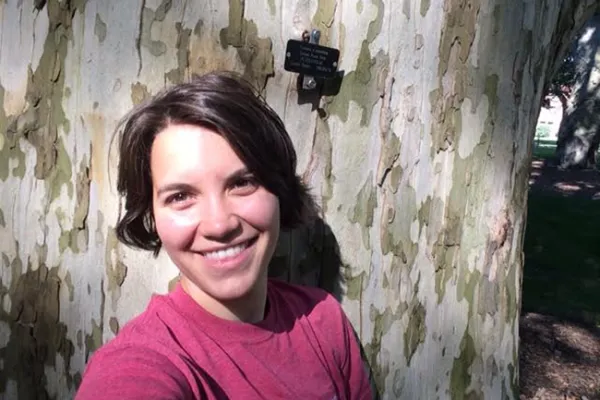Trees that Teach: Taz Mueller ’18 Creates Digital Portal About Campus Trees
Campus Life

Published August 23, 2016
When Taz Mueller ’18 walks through campus, she sees the ghosts of tree canopies past.
“The entire campus was once covered by elms and oaks,” says Mueller, a biology major and the student representative on Smith’s new Campus Tree Advisory Committee. “Because I’ve looked through the archives, I can see the layers of what used to be.”
Mueller has spent many hours this summer in the College Archives on “a massive hunt” for information about campus trees. A participant in Smith’s Summer Research Fellows (SURF) program, she hopes to create an online portal where users can find complete profiles of important college trees.
Mueller is launching the portal—which should be online sometime this fall—by focusing on five special trees: the London Planetree on Seelye Lawn; the Dawn Redwood outside of Neilson Library; the Camperdown Elm next to Lyman Conservatory; the Ginkgo tree near Burton Hall; and the American Elm on Chapin Lawn near Wright Hall.
By offering details on things such as each tree’s place in the college’s timeline to the size of its shade footprint, Mueller hopes the portal will boost awareness of the many ways trees contribute to daily life at the college.
Our trees also teach. We tag them with information for anyone to read, use them as learning tools and manage them as a collection.
Mueller’s summer project builds on past research by fellow Smithies, as well as information compiled by the Smith College Botanic Garden, Facilities Management and other college departments. To create the portal, she has pored over planting plans, steam line maps and student projects on heritage campus trees—among other sources.
“Taz’s project is an effort to synthesize and make visible all the ways a tree is important to the college,” says Gaby Immerman, who teaches horticulture at Smith and is Mueller’s SURF project adviser. “We’re trying to capture that full picture and create a place where information will be easily accessible to students, faculty, campus planners, Facilities Management and the public.”
Steven Moga, assistant professor of landscape studies, notes that on a campus that was designed as an arboretum, Smith trees provide more than scenery.
“Our trees also teach,” says Moga, who also sits on the Campus Tree Advisory Committee. “We tag them with information for anyone to read, use them as learning tools and manage them as a collection.”
Many of the college’s oldest and largest trees pre-date online records, Moga points out, making archival research key to understanding how those trees have fared over the years.
Mueller, who has been interested in plants since she was a child, entered Smith with plans to major in studio art. After her first horticulture class, she switched to biological sciences and began interning at the botanic garden.
Her SURF project was inspired by Smith’s joining the Tree Campus USA program in 2015. Sponsored by the national Arbor Day Foundation, the program recognizes colleges that meet tree conservation standards—including the creation of tree advisory committees.
Mueller envisions the new portal as an interactive map where users can get to know individual Smith trees from “every angle”—spatial, biological, historical and ecological.
As for whether she has a favorite, “I like all of the trees for different reasons,” Mueller says. “The elm near Neilson arch is one—we won’t be seeing a specimen like that for another century. I also love the Stewartia in Capen Garden.”
Learning about trees the college has lost over the years to building projects, disease and storm damage has made Mueller even more grateful for the hundreds still providing shade and beauty on campus.
“We’ve got to preserve our arboretum,” says Mueller, who will continue working on the portal in an independent study this fall. “The way trees contribute to Smith is huge.”
Taz Mueller ’18 in a selfie with the London Planetree on Seelye Lawn, one of her favorite campus trees.